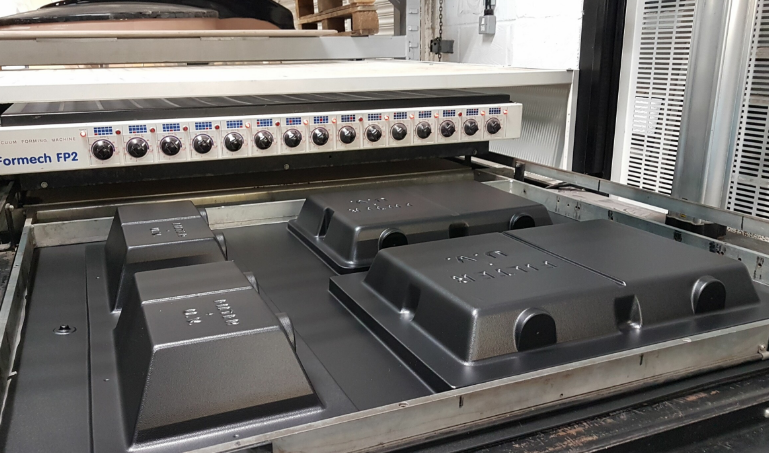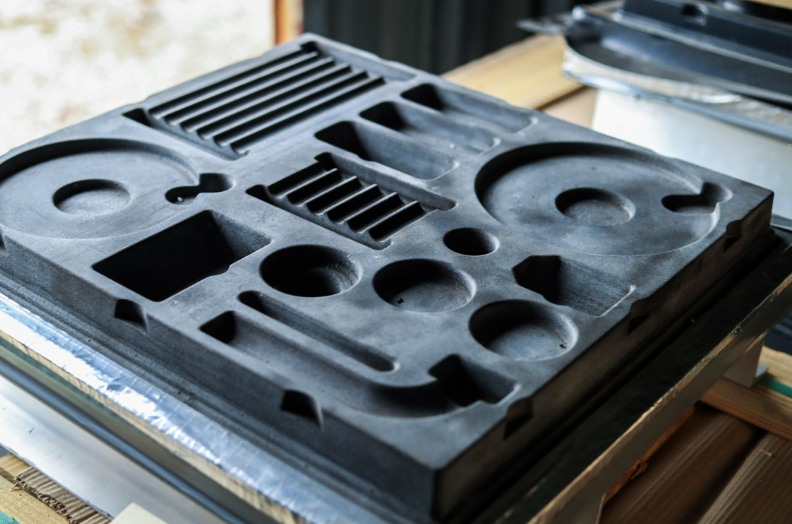The most commonly used polymer for vacuum forming is High Impact Polystyrene (HIPS).
Overview of Vacuum Forming
Vacuum forming, a type of thermoforming, uses heat and vacuum to shape plastics.

Definition and Basic Principles
Vacuum forming involves heating a plastic sheet until pliable, then stretching it over a mold. A vacuum sucks the sheet onto the mold, shaping it. Key factors include:
Temperature: The plastic heats to about 250°F – 300°F.
Pressure: Vacuum pressure is typically 10 – 25 inches of mercury.
Cooling: The shaped plastic cools and hardens on the mold.
History and Evolution of Vacuum Forming
Developed in the 1930s, vacuum forming has evolved significantly. From its simple beginnings, it now incorporates advanced technologies for better precision and efficiency.
1950s: Polymers improved, expanding applications.
Today: Digital design and automation enhance its capabilities.
Technical Aspects:
Power Usage: Modern machines use 3 – 10 kW, focusing on energy efficiency.
Production Speed: Rates vary from 1 to 5 cycles per minute.
Size Limits: Maximum sizes are usually around 6 feet by 10 feet.
Material Thickness: Plastic sheets range from 0.005 to 0.5 inches thick.
For detailed information, visit Vacuum Forming on Wikipedia.
Common Polymers Used in Vacuum Forming
Vacuum forming, a versatile manufacturing process, employs various polymers. Each polymer’s unique properties determine its suitability for specific applications.
Characteristics of Ideal Polymers for Vacuum Forming
Ideal polymers for vacuum forming are characterized by:
High Formability: They should easily shape under heat.
Robustness: Polymers must withstand stress without damage.
Affordability: Cost-effectiveness is crucial for economic manufacturing.
Chemical Resistance: This ensures longevity in diverse environments.
Aesthetic Appeal: Good color and surface finish are important.
Comparison of Different Polymers
Acrylonitrile Butadiene Styrene (ABS):
Cost: Around $1.50 – $2.50 per pound.
Benefits: ABS is tough and impact-resistant.
Use Cases: It’s preferred in automotive and consumer products.
Limitation: Not ideal for high-temperature applications.
Polycarbonate (PC):
Cost: Typically $2.75 – $3.50 per pound.
Benefits: Known for its strength and heat resistance.
Use Cases: Used in safety equipment and medical devices.
Limitation: More expensive and scratch-prone.
Polyethylene Terephthalate Glycol (PETG):
Cost: Usually $2.00 – $2.80 per pound.
Benefits: PETG offers clarity and chemical resistance.
Use Cases: Common in packaging and medical sectors.
Limitation: It is less rigid than ABS or PC.
High Impact Polystyrene (HIPS):
Cost: Ranges from $1.20 to $1.80 per pound.
Benefits: Easy to print and paint, moderately impact-resistant.
Use Cases: Ideal for promotional items and model making.
Limitation: Not suitable for high-heat uses.
Polyvinyl Chloride (PVC):
Cost: About $0.80 – $1.50 per pound.
Benefits: Offers fire and chemical resistance.
Use Cases: Widely used in construction and healthcare.
Limitation: Environmental and health concerns in production.
Polypropylene (PP):
Cost: Generally $1.00 – $2.00 per pound.
Benefits: PP is fatigue-resistant and semi-rigid.
Use Cases: Great for automotive parts and packaging.
Limitation: Hard to paint and bond.
For more details, explore Polymers on Wikipedia.
Detailed Analysis of the Most Used Polymer
In vacuum forming, Acrylonitrile Butadiene Styrene (ABS) stands out as the most commonly used polymer.

Chemical and Physical Properties
ABS showcases a unique set of properties:
Composition: It’s a thermoplastic polymer made from acrylonitrile, butadiene, and styrene.
Melting Point: ABS melts at approximately 221°F (105°C).
Density: Typically, it has a density of about 1.04 g/cm³.
Advantages in Vacuum Forming Applications
Impact Resistance: Its robustness makes it ideal for products needing durability.
Heat Stability: ABS withstands moderate temperatures without deforming.
Versatility: It can be easily colored and finished for aesthetic appeal.
Cost-Effectiveness: With a price range of $1.50 – $2.50 per pound, it’s affordable for large-scale production.
Applications of ABS in Vacuum Forming:
Consumer Electronics: For its aesthetic versatility and strength.
Packaging Materials: Its impact resistance makes it suitable for protective packaging.
Limitations of ABS:
Temperature Sensitivity: It’s not suitable for high-temperature applications.
Chemical Sensitivity: Certain chemicals can degrade ABS over time.
For an in-depth exploration of ABS properties and applications, visit ABS on Wikipedia.
Manufacturing Process Using the Polymer
Step-by-Step Vacuum Forming Process
| Step | Description | Details |
|---|---|---|
| Heating the Polymer | ABS sheet is heated until it becomes pliable. | Temperature Range: 250°F – 300°F |
| Molding | The heated sheet is draped over the mold. | Vacuum Pressure: 10 – 25 inches Hg |
| Vacuum Application | A vacuum is applied to form the sheet tightly around the mold. | Efficiency: Reduces forming time |
| Cooling and Release | The formed material cools and solidifies, then is removed from the mold. | Cooling Time: Varies by thickness |
| Trimming | Excess material is trimmed, resulting in the final product shape. | Precision: Crucial for final fit |
Techniques for Enhancing Quality and Efficiency
| Technique | Application | Impact |
|---|---|---|
| Precise Temperature Control | Ensuring consistent heating of the ABS sheet. | Quality: Improves formability and finish |
| Mold Design Optimization | Designing molds for easy release and minimal material waste. | Efficiency: Reduces production time |
| Automated Trimming | Using automated cutting for precise and consistent trimming. | Speed: Increases production rate |
| Quality Control Checks | Regular inspections to maintain product standards. | Consistency: Ensures high product quality |
| Recycling Excess Material | Reusing or recycling trimmed ABS material. | Cost-Effectiveness: Reduces waste |
Power and Cost Aspects:
Power Consumption: Machines typically use 3 – 10 kW.
Material Cost: ABS costs $1.50 – $2.50 per pound.
For a comprehensive understanding of vacuum forming and ABS, explore Vacuum Forming on Wikipedia and ABS on Wikipedia.




